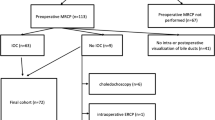Abstract
This study aimed to assess the clinical usefulness of magnetic resonance cholangiopancreatography (MRCP) as a postoperative diagnostic tool in children with choledochal cysts. Magnetic resonance cholangiopancreatography was performed postoperatively in 19 patients and image quality was compared with that obtained by intravenous cholangiography spiral computed tomography (IVC-SCT). While the detectability by MRCP was inferior to that by IVC-SCT, MRCP highly (84.2%) depicted the anastomotic site together with the reconstructed bowel and intrahepatic bile ducts. Magnetic resonance cholangiopancreatography also clearly delineated the postoperative condition of pancreaticobiliary maljunction (PBM), residual distal common bile duct, common channel, and pancreatic duct. Since MRCP is noninvasive and requires neither radiation exposure nor a contrast agent, and is useful for detecting both anastomosis and pancreatico-biliary ducts around PBM, MRCP might be superior to IVC-SCT as an imaging technique for outpatient clinics performing long-term follow-up studies in children with choledochal cysts.


Similar content being viewed by others
References
Todani T, Watanabe Y, Toki A et al. (1988) Reoperation for congenital choledochal cyst. Ann Surg 207:142–147
Hamada Y, Sato M, Sanada T et al. (1995) Spiral computed tomography for biliary dilatation. J Pediatr Surg 30:694–696
Hamada Y, Sato M, Takada K et al. (1998) Spiral computed tomography for bilioenteric anastomotic stricture. Pediatr Surg Int 13:424–425
Yamataka A, Kuwatsuru R, Shima H et al. (1997) Initial experience with non-breath-hold magnetic resonance cholangiopancreatography: a new non-invasive technique for the diagnosis of choledochal cyst in children. J Pediatr Surg 32:1560–1562
Dinsmore JE, Murphy JJ, Jamieson D (2001) MRCP evaluation of choledochal cysts. J Pediatr Surg 36:829–830
van Heurn-Nijsten EWA, Snoep G, Kootstra G et al. (1999) Preoperative imaging of a choledochal cyst in children: non-breath-holding magnetic resonance cholangiopancreatography. Pediatr Surg Int 15:546–548
Lam WWM, Lam TPW, Saing H et al. (1999) MR cholangiography and CT cholangiography of pediatric patients with choledochal cysts. AJR 173:401–405
Kim SH, Lim JH, Yoon HK et al. (2000) Choledochal cyst: comparison of MR and conventional cholangiography. Clin Radiol 55:378–383
Hirohashi S, Hirohashi R, Uchida H et al. (1996) MR cholangiography in children with pancreatitis (Abstract). Radiology 201:137
Author information
Authors and Affiliations
Corresponding author
Rights and permissions
About this article
Cite this article
Hamada, Y., Tanano, A., Takada, K. et al. Magnetic resonance cholangiopancreatography on postoperative work-up in children with choledochal cysts. Ped Surgery Int 20, 43–46 (2004). https://doi.org/10.1007/s00383-003-1079-1
Published:
Issue Date:
DOI: https://doi.org/10.1007/s00383-003-1079-1




